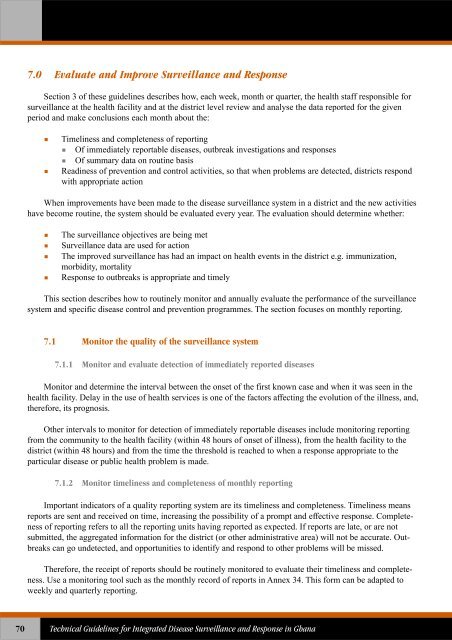Technical Guidelines for Integrated Disease Surveillance ... - PHRplus
Technical Guidelines for Integrated Disease Surveillance ... - PHRplus
Technical Guidelines for Integrated Disease Surveillance ... - PHRplus
Create successful ePaper yourself
Turn your PDF publications into a flip-book with our unique Google optimized e-Paper software.
7.0 Evaluate and Improve <strong>Surveillance</strong> and ResponseSection 3 of these guidelines describes how, each week, month or quarter, the health staff responsible <strong>for</strong>surveillance at the health facility and at the district level review and analyse the data reported <strong>for</strong> the givenperiod and make conclusions each month about the:Timeliness and completeness of reporting Of immediately reportable diseases, outbreak investigations and responses Of summary data on routine basisReadiness of prevention and control activities, so that when problems are detected, districts respondwith appropriate actionWhen improvements have been made to the disease surveillance system in a district and the new activitieshave become routine, the system should be evaluated every year. The evaluation should determine whether:The surveillance objectives are being met<strong>Surveillance</strong> data are used <strong>for</strong> actionThe improved surveillance has had an impact on health events in the district e.g. immunization,morbidity, mortalityResponse to outbreaks is appropriate and timelyThis section describes how to routinely monitor and annually evaluate the per<strong>for</strong>mance of the surveillancesystem and specific disease control and prevention programmes. The section focuses on monthly reporting.7.1 Monitor the quality of the surveillance system7.1.1 Monitor and evaluate detection of immediately reported diseasesMonitor and determine the interval between the onset of the first known case and when it was seen in thehealth facility. Delay in the use of health services is one of the factors affecting the evolution of the illness, and,there<strong>for</strong>e, its prognosis.Other intervals to monitor <strong>for</strong> detection of immediately reportable diseases include monitoring reportingfrom the community to the health facility (within 48 hours of onset of illness), from the health facility to thedistrict (within 48 hours) and from the time the threshold is reached to when a response appropriate to theparticular disease or public health problem is made.7.1.2 Monitor timeliness and completeness of monthly reportingImportant indicators of a quality reporting system are its timeliness and completeness. Timeliness meansreports are sent and received on time, increasing the possibility of a prompt and effective response. Completenessof reporting refers to all the reporting units having reported as expected. If reports are late, or are notsubmitted, the aggregated in<strong>for</strong>mation <strong>for</strong> the district (or other administrative area) will not be accurate. Outbreakscan go undetected, and opportunities to identify and respond to other problems will be missed.There<strong>for</strong>e, the receipt of reports should be routinely monitored to evaluate their timeliness and completeness.Use a monitoring tool such as the monthly record of reports in Annex 34. This <strong>for</strong>m can be adapted toweekly and quarterly reporting.70<strong>Technical</strong> <strong>Guidelines</strong> <strong>for</strong> <strong>Integrated</strong> <strong>Disease</strong> <strong>Surveillance</strong> and Response in Ghana















